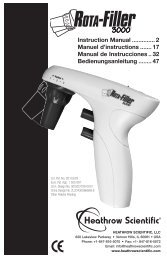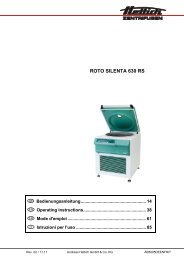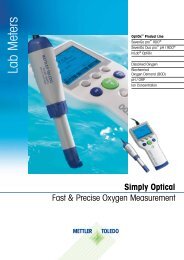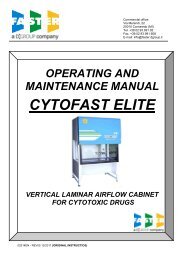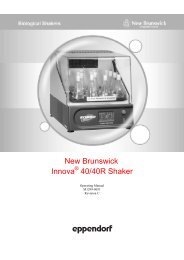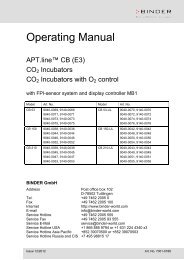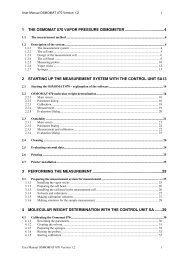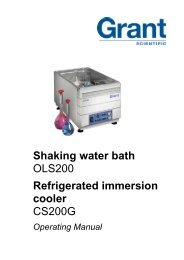Gradient Master - Wolf Laboratories
Gradient Master - Wolf Laboratories
Gradient Master - Wolf Laboratories
You also want an ePaper? Increase the reach of your titles
YUMPU automatically turns print PDFs into web optimized ePapers that Google loves.
<strong>Wolf</strong> <strong>Laboratories</strong> Limited<br />
www.wolflabs.co.uk<br />
Tel: 01759 301142 Fax:01759 301143 sales@wolflabs.co.uk<br />
Use the above details to contact us if this literature doesn't answer all your<br />
questions.<br />
Pricing on any accessories shown can be found by keying the part number<br />
into the search box on our website.
WOLF LABS<br />
Tel: 01759 301142 Fax: 01759 301143 E-mail: sales@wolflabs.co.uk<br />
<strong>Gradient</strong> <strong>Master</strong><br />
This is biocomp's premier gradient forming instrument.<br />
in as little as 40 sec, you can produce 6 identical, linear gradients using a patented process<br />
we call tilted tube rotation. The process involves layering the two end point solutions (i. E.<br />
5% and 30% sucrose) directly in the centrifuge tube, capping it and placing it in a special<br />
tube holder with a magnetic base (magnabase ) that adheres to a steep plate on the<br />
instrument. Two keystrokes later, the gradient master takes over and tilts the tube to the<br />
proper angle, rotates it for a designated time and returns it to its original vertical position.<br />
The introduction of the model 107 is the latest step in the evolution of this remarkable<br />
instrument. It has several new features that distinguish it from previous models. First, its<br />
memory contains all the run parameters for all the many different gradients we have<br />
developed for our customers. To see the list, select the rotor (ie sw41) you are using and<br />
then scroll through a list of the gradients organized by % and solute. To simplify things<br />
further, the last key on the keyboard recalls the last gradient run, so 2 keystrokes are all<br />
that are needed to duplicate a run.<br />
Second, the unit is now internet programmable. You can download new software yourself as<br />
upgrades become available. The gradient catalog is also upgradable so users can benefit<br />
from our ever-expanding set of run parameters. Solutes used so far include sucrose,<br />
glycerol, optiprep®, nycodenz®, ficoll®, percoll®, metrizamide, renografin®, nacl, cscl, naac,<br />
kcl. Like the old saying, the gradient master has never met a solute it didnt like.<br />
The gradient master is also a patented, intelligent roller blot device that can perform all the<br />
blocking, blotting and reaction steps with unerring accuracy and reproducibility. Using our<br />
patented magnabase bottles which come in a variety of sizes to fit every blot without<br />
overlap, you can reduce your reagent use by 90% while obtaining superb blots.<br />
If you are serious about your gradient work, there is no competition for the gradient master.<br />
In nearly a thousand labs around the world for 18 years, it has become the gradient former<br />
of choice because of its simplicity, incredible speed and durability. features:the base unit<br />
includes a backlit lcd display, control knob and "smart" keypad for data entry and control. A<br />
6" steel plate is tilted and turned by two stepper motors. The kit includes mac and pc serial<br />
cables for programming the unit, a bubble level, two 4 cannula for layering of gradient<br />
solutions and a selection of allen wrenches for maintenance.
<strong>Gradient</strong> Fractionator<br />
The era of high resolution gradient analysis has finally arrived. Introducing biocomps<br />
incomparable piston gradient fractionator, the worlds highest resolution fractionator.<br />
developed by a scientist who routinely does 6-30 gradient experiments, this device has more<br />
performance-enhancing features than all competing designs combined. You can recover<br />
slices from the gradient as small as 10 microns thick (300 micron fractions are more typical),<br />
visualize bands of particles as small as ribosomes with the naked eye, fractionate manually<br />
to recover visible bands or automatically to produce perfect gradient profiles, and rinse and<br />
blow dry your sample tubing after each fraction, eliminating cross-contamination between<br />
fractions.<br />
The most important technical advance is our patented trumpet tip , an inverted tapered<br />
piston cone that gradually compresses bands of particles from horizontal discs into thin<br />
vertical columns. This advance greatly reduces the resolution-killing laminar capillary flow<br />
that tends to pull sample from a teardrop shaped area directly in front of the needle or cone<br />
used by our competitors.<br />
Another significant improvement is the readout of distance (0. 00 mm) from the meniscus<br />
down, so you know exactly where you are sampling in the tube.<br />
the results are nothing short of spectacular. In a recent paper, jardine & coombs (1998)<br />
resolved 4 distinct peaks of phage t4 capsids between 300s - 350s where previous reports<br />
fractionated by needle puncture had shown only one broad peak. One of the new particles<br />
was a new intermediate in head assembly that demonstrated that capsid expansion followed<br />
the beginning of dna packaging.<br />
The combination of the gradient master and the piston gradient fractionator offer a quantum<br />
leap in reproducibility and resolution. Call today for details. features:<br />
• visible light scattering band visualization system for particles as small as viruses and<br />
ribosomes.<br />
• >99% accuracy and reproducibility in piston movement with readout to 0. 01 mm.<br />
• programmable fractionation and rinsing.<br />
• rinse and air pumps to clean sample tubing after each fraction.
• patented trumpet tip piston gradually compresses thin bands of particles into<br />
vertical columns prior to capture.<br />
• uv scan capability with optional pharmacia uvm ii attachment.<br />
• internet programmability: the software installed in an instrument you purchase today<br />
is upgradable by simply downloading a new version into the fractionator directly from<br />
your computer using a supplied serial cable.<br />
<strong>Gradient</strong> Station<br />
This newly developed hybrid instrument performs both gradient forming and fractionating. The<br />
performance of its two elements, the Piston <strong>Gradient</strong> Fractinator and the <strong>Gradient</strong> <strong>Master</strong> is<br />
identical to the separate instruments.<br />
Please contact us on 01759 301142 or sales@wolflabs.co.uk for further information.
BH4 Fractionator<br />
Researchers working with deadly viruses at the NIH in Bethesda and Ft.<br />
Detrick MD asked us to develop a gradient fractionator that would be easily<br />
transported and fit inside the BSC4 hood. The standard <strong>Gradient</strong> Station or<br />
Piston Fractionator are too heavy and too large to fit these requirements, so<br />
we set out to reduce the height of the device and shave off some of its weight.<br />
The result is a fractionator that, at 9.5 kg, weights half as much as the<br />
standard one and fits easily into most BioHazard hoods. It has all the same<br />
features as the standard fractionator and uses the same tube holders as well.<br />
The maximum height allowed was 65 cm, but the new design comes in at 63<br />
cm. The danger of emitting dangerous aerosols during fractionation has been<br />
eliminated by removing the air pump, but it can be included it if desired.<br />
6-Piston Fractionator<br />
As the inventor of the piston fractionator, I was fortunate to be able to<br />
construct the fractionator of my dreams. My laboratory at the University of<br />
New Brunswick was studying phage T4 morphogenesis and routinely ran 6 to<br />
12 gradients every day. In some cases we harvested individual bands we<br />
could see with the light scattering visualization system, while in others we
fractionated the gradient into individual equal fractions. At some point, I was<br />
taken by the idea that I could determine the entire T4 assembly pathway in<br />
vivo with a pulse chase experiment, taking dozens of samples at 20 second<br />
intervals. In the end, 42 gradients were required for each experiment, so<br />
something had to give on the fractionation end of the experiment. This gave<br />
birth to the 6-piston fractionator, permitting us to fractionate a whole bucketload<br />
of gradients while the next set was in the centrifuge. Imagine doing 42<br />
sucrose gradients in a single day! The result was an amazing experiment that<br />
mapped the in vivo assembly pathway of the T4 tail (see Ferguson and<br />
Coombs, 2000, JMB).<br />
Fast forward to 2010, when a researcher studying carbon nanotubes who had<br />
purchased the <strong>Gradient</strong> Station asked if we could make him a new version of<br />
the 6-P, as we call it, so he could increase his production to preparative<br />
levels. There are a many things that needed to be redesigned because he<br />
wanted to do gradients using CHCl3 and isopentane instead of sucrose, and<br />
these noxious chemicals damaged many components in the fluid path. The 6-<br />
P is now available, whether you are doing aqueous gradients (sucrose, etc.)<br />
or organic solvent gradients. Let your imagination go where this new<br />
opportunity takes you.<br />
NanoFrac and NanoStation<br />
These variants of the standard PGF and Station are built for the nanotube,<br />
nanoparticle investigator. They incorporate all the lessons we learned<br />
designing and building the 6-P, so they tolerate both aqueous and organic<br />
solvents and most importantly, offer two types of illumination of the gradient:<br />
light scattering (white bands on black background) and colour (coloured<br />
bands on a white, backlit background). The key innovation was the use of the<br />
same light source for both types of gradients. The lamp can be positioned<br />
under the gradient for light scattering, or moved to the back, where it shines<br />
up through a glass window and reflects forward toward the back of the<br />
gradient with a slanted mirror. The tube holders are equipped with black and<br />
white inserts that are placed behind the tube in the tube holder for the two<br />
types of illumination.
THE<br />
GRADIENT PRIMER<br />
v2.3<br />
by David Coombs, Ph.D.<br />
BioComp Instruments Inc.<br />
© 2010
Density <strong>Gradient</strong> Primer<br />
Contents:<br />
Section 1. <strong>Gradient</strong> Theory.<br />
1.0 The stable liquid column<br />
1.1 The choice of solute; density, viscosity, osmolarity<br />
1.2 Rate zonal (velocity) vs. Isopycnic (equilibrium) centrifugation<br />
Section 2. Forming density gradients<br />
2.0 Step gradients<br />
2.1 Non-linear gradients; exponential/isokinetic<br />
2.2 Linear gradients (two chambers, freeze thaw, lay it flat)<br />
2.3 Tilted tube rotation<br />
2.4 Cushions and shelves<br />
2.5 Temperature<br />
Section 3. Layering and handling gradients.<br />
3.0 Sample preparation<br />
3.1 Sample layering for velocity runs<br />
3.1.a. <strong>Gradient</strong> preparation<br />
3.1.b. The layering device<br />
3.1.c. Sample preparation<br />
3.1.d. Sample layering<br />
3.2 <strong>Gradient</strong> buffers<br />
3.3 Sample size, layering and band compression<br />
3.3.a The value of a steep gradient.<br />
3.4 Loading the tubes in the rotor, running, unloading<br />
Section 4. Fractionating gradients<br />
4.0 The essential problem: Laminar capillary flow<br />
4.1 Needles; straight and side hole:<br />
4.2 Cones<br />
4.3 The Trumpet Tip<br />
4.4 A Comparison of different tip designs<br />
4.5 The Piston Fractionator<br />
4.6 The highest resolution fractionation ever achieved.<br />
4.6.a. High resolution and reproducibility<br />
4.6.b. Teasing out new species<br />
4.6.c. Resolving small protein complexes<br />
4.6.d . Resolving carbon nanotubes<br />
4.7 The band visualization system and manual fractionation<br />
4.8 First drop/Reset; synchronizing gradient profiles.<br />
4.9 Fraction size<br />
4.10 Sampling the bottom of the tube<br />
4.11 U.V. fractionation<br />
4.12 The rinse/air valve system<br />
Section 5. Post-gradient sample manipulations<br />
5.1 TCA/SDS-PAGE<br />
5.2 Native gels<br />
5.3 Scintillation counting<br />
5.4 UV detection<br />
2
Section 1. <strong>Gradient</strong> Theory.<br />
1.0 The stable liquid column<br />
Density gradients are marvellous creatures with unlimited potential for separation of<br />
biomolecules. They can be of any composition and volume and centrifuged in a variety of modes that<br />
can influence the separation. This primer is a modest attempt to explain the use of this time-honored<br />
technique at a time when its use has declined in the face of “higher tech” solutions. We will attempt<br />
to highlight its continued utility and the multiple advantages it has over other separation techniques.<br />
The most important part of a density gradient is its density gradient. This may sound obvious<br />
and trite, but it is widely overlooked. The density gradient is the source of the gradient’s stability as<br />
well as its capacity for separation. The top of the gradient must be dense enough to support the<br />
sample and the column must have enough of a density gradient to remain stable during the<br />
centrifugation and fractionation of the tube. Thus, a 15-20% sucrose gradient will be much less stable<br />
than a 5-45% gradient.<br />
You can appreciate the need for stability by thinking of the contents of the tube as centrifugation<br />
begins and ends. There is a period at both ends of a run when the tube is rotating in a vertical<br />
position with centrifugal force applied to its side, and two other periods when this force is gradually<br />
transferred to or from the vertical axis of the tube as the bucket begins to swing out at the beginning<br />
of the run or down at the end of the run. These are difficult times for the gradient and the only thing<br />
that prevents vertical mixing is the steepness of the gradient. Moral: the greater the change in %<br />
between the top and bottom of a gradients, the more stable it is. As a general rule, the delta % should<br />
be ≥20% and as high as 40%.<br />
1.1 The choice of solute; density, viscosity, osmolarity<br />
The choice of solute is dictated by the type of separation desired. Density gradients have been<br />
constructed from many solutes in the past 40 years so it might be useful to list some of the<br />
more common ones and describe their uses and limitations:<br />
Sucrose: By far and away the most common solute. It is cheap, very soluble, chemically inert and<br />
does not absorb in the UV. It has very high osmolarity, so it tends to be unkind to living<br />
cells, and at its maximum density is incapable of supporting biomolecules other than lipids,<br />
so its use is limited to rate zonal gradients for the most part.<br />
Glycerol: A substitute for sucrose, sharing most of tis properties. Used in cases where sucrose is<br />
harmful or insoluble in the downstream treatment of fractions.<br />
CsCl (NaCl, KCl, KBr, LiCl): These salt gradients are useful when nucleic acids are banded, since<br />
the high solubility and density of some of these solutes can float these dense biomolecules.<br />
These gradients lack the viscosity of sucrose gradients and are less stable as a result (handle<br />
with care). The denser of these solutes (CsCl and LiCl) will form gradients on their own<br />
under centrifugal force, so it is possible to simply mix the salt directly in the sample and let<br />
the gradient form during an overnight run. The steepness of the gradient depends on the<br />
speed of the rotor (the x Gs applied to the tube).<br />
K Acetate: Used in velocity banding of DNA/RNA fragments which are recovered from the<br />
fractions by adding isopropanol and precipitating the nucleic acid.<br />
Percoll: Pharmacia introduced Percoll many years ago as a low osmolarity solute suitable for<br />
whole cell purification. It is widely used in cell biology. It has one unusual property that has<br />
limited its use: It is actually a suspension of tiny silica particles coated with<br />
3
polyvinylpyrrolidone (PVP) that can not be removed by dialysis. It self-forms gradients<br />
under centrifugation.<br />
Nycodenz: Originally developed as a radio-opaque dye for blood work, this Nycomed (now<br />
Axis-Shield)product has seen many years of use in cell purification. It has low osmolarity, is<br />
dialysable and its gradients are self-forming.<br />
Optiprep (iodixanol): A recent upgrade from Nycomed developed as a radio-opaque dye but<br />
currently enjoying robust gradient use, it shares many of Nycodenz’s properties and is less<br />
toxic in some applications.<br />
Renografin (tri-iodinated benzoic acid, also called Angiografin, Hypaque, Renografin,<br />
Urografin, Urovison): An early radio-opaque dye used for density gradients, it is no longer<br />
seeing much use, since it had some serious health issues and is difficult to source.<br />
Metrizamide (Amipaque): The earliest radio-opaque dye. Same as Renografin, but with a slightly<br />
different chemical structure.<br />
Ficoll: A high molecular weight sucrose polymer used in some cell separations.<br />
Dextran: A high molecular weight polymer of glucose. See Ficoll.<br />
With so many choices, it is difficult to choose the right medium for the job. Your best bet is to<br />
use PubMed and search with the words “gradient” AND “your particle of interest” and see what<br />
others have done, i.e. “gradient AND polysomes”.<br />
If you are intent on striking out on your own, choose the solute that best matches your needs. If<br />
purifying a proteinaceous particle, sucrose or glycerol are usually the solutes of choice. If you want<br />
to separate membrane fractions, you can sometimes still use these two solutes, but if the membranes<br />
contain more proteins than these solutes can support, then a denser medium is needed and the<br />
iodinated compounds are used. Whole cell preparations require the higher density, low osmolarity<br />
solutes.<br />
1.2 Rate zonal (velocity) vs. Isopycnic (equilibrium) centrifugation<br />
The kind of gradient you should use depends on the particle of interest and the other<br />
particles it is being separated from.<br />
Velocity or rate zonal runs separate things on the basis of their mass and to a lesser extent<br />
on their density and shape. With these gradients, there is no point in the gradient capable of<br />
supporting the density of the particle of interest. Consequently, the particle will continue to sediment<br />
through the gradient as long as centrifugal force is applied. Separation is based on a particle’s S value<br />
(Svedberg units). This type of gradient is used when the particle has a unique S value. Ribosomes<br />
(30S, 50S, 70S), phage and virus particles and sub assemblies (15S - 1200S) are typical examples. The<br />
separation is exquisitely sensitive to subtle changes in mass, density and shape and can reveal much<br />
in the way of a particle’s composition, conformation and assembly.<br />
The % sucrose or glycerol used can have a large impact on the separation. For separations<br />
of particles with similar S values, a relatively shallow gradient is used (i.e. 5-30%), whereas if the<br />
particles have very different S values (120S and 1200S), a steeper gradient is used (i.e. 5-45%). The<br />
viscosity of sucrose and glycerol solutions increase exponentially at high concentrations (they<br />
become syrupy), and this greatly increases the drag on the faster particles as they enter the bottom<br />
half of the gradient, allowing the lower S value particles to continue to separate from the cellular<br />
debris in the top half.<br />
4
Often overlooked is the need for the top of the gradient to support the sample as it is<br />
layered on before the run. 5% solute is usually dense enough, but in cases of very concentrated<br />
extracts, 10% solute might be needed. Given that steeper gradients are usually better than shallow<br />
ones, the lowest % top solute needed will give a higher slope. More on this in the layering section<br />
below.<br />
The name “rate zonal” derives from the fact that the particles are applied to the top of the<br />
gradient as a thin “zone” and migrate through the gradient as distinct zones. Sample size obviously<br />
matters here if the zone is to be thin in the first place, hence we have designed the Short cap (-R)<br />
which leaves 4 mm or room for the sample when it is removed (see below). We have shown that<br />
samples less than 3 mm in height as they sit on top of the gradient give essentially the same bands<br />
and that steep gradients can actually compress bands as they migrate through the tube (see the data<br />
below).<br />
A little known fact about rate zonal gradients is the observation that sample losses become<br />
serious as the particles sediment to the bottom of the tube. The source of these losses is unknown,<br />
but may involve the collision of the particles with the wall and their subsequent loss from the band.<br />
The rule of thumb is to use the top 2/3 of the tube whenever possible for your best separation.<br />
Equilibrium or isopycnic runs are a completely different from rate zonal ones. As their<br />
name implies, the particles of interest come to rest at their “isopycnic point”, the point in the density<br />
gradient that matches their density. No matter how long they are centrifuged after that, they remain<br />
in the same position.<br />
Consequently, sample size is irrelevant so long as the gradient contains the isodense<br />
(isopycnic) zone capable of floating the particle. Since sample volumes are generally much greater<br />
than in rate zonal runs, we have designed a Long cap (-I, 10 mm) for our gradient forming system<br />
(see below).<br />
Samples can be applied to the top of the gradient or the bottom (in a suitable dense<br />
solution) from whence they “float” to their position. They can also be mixed with the solute in the<br />
case of self-forming gradients like CsCl and placed in the tube without a gradient being preformed.<br />
The speed of the rotor is very important here for it influences the rate at which the particles are<br />
driven to their isopycnic point and also because it can also impact on the shape of the gradient.<br />
As noted above, most of the equilibrium density media like CsCl or Optiprep are selfforming,<br />
so that if you centrifuge 12-16 hr, a gradient will form at equilibrium with a shape that is<br />
dependent on the speed of the rotor: higher speeds yield steeper gradients. Pre-forming density<br />
gradients for isopycnic runs drastically reduces the run time, since particles begin to move<br />
immediately rather than waiting for the gradient to be established.<br />
Section 2. Forming density gradients<br />
2.0 Step gradients<br />
Step gradients are of very special but limited utility. The goal is to create a series of steps in<br />
density that will separate the particle if interest from its undesirable neighbors in a quick and dirty<br />
way. For example, if the particle density is 1.12 g/cc, the steps of 1.09 and 1.15 g/cc would trap these<br />
particles at the interface between the two steps in the very thin zone where this density exists. The<br />
downside is that these gradients are often used to separate membrane fractions when no real classes<br />
exist: they take a smear and make it look deceptively good by concentrating into a series of steps.<br />
When layering these gradients, start with the lightest step and underlay the next heavier<br />
step to avoid disturbing the step above. Withdraw the needle as you layer, keeping just below the<br />
5
interface of the two steps.<br />
2.1 Non-linear gradients; exponential/isokinetic<br />
In the 1960’s and 70’s, there was some interest in these unusual gradients because they<br />
matched the increasing rate of sedimentation at higher radii with an exponential increase in solute<br />
and viscosity, giving a dead heat: particles sedimented at the same rate over the entire length of the<br />
tube. The gradient forming part was very tricky, with the mixing chamber of the two chamber<br />
device (see below) sealed off to give a constant volume that the other solution diluted exponentially<br />
rather than linearly. The fad seems to have passed.<br />
2.2 Linear gradients (two chambers, freeze thaw, lay it flat)<br />
Linear gradients are the most widely used type, both for rate zonal and equilibrium runs.<br />
They can be formed a number of different ways with varying degrees of difficulty and<br />
reproducibility. The simplest way to make them is with the standard two-chamber device in use since<br />
the dawn of centrifugation. Equal volumes of the heavy and light solution are placed in adjacent<br />
chambers and allowed to mix in one chamber on their way into the tube. Done carefully, this is the<br />
best way to make a linear gradient. However, there are many problems with this method: the<br />
chambers don’t always empty at the same rate, one can only make a single gradient at a time.<br />
A while back, someone discovered that you could freeze and thaw a homogeneous solution<br />
of sucrose in a tube a couple of times and the exclusion of the solute as the water froze into ice would<br />
lead to pure water and concentrated solute, eventually forming a gradient. Before you head off to<br />
your local freezer, however, beware of the technique that seems to be too good to be true. It is! The<br />
gradients are non-linear, they take days to cycle through the multiple freeze-thaws and most<br />
importantly, they are a gradient of everything, not just sucrose. All solutes are excluded from the ice<br />
and all end up forming a gradient, so you end up with a buffer gradient, a salt gradient and perhaps a<br />
bit of a pH gradient as well. The top of these gradients is essentially pure water, which is incapable of<br />
supporting a sample layered on top. Do not use these gradients!<br />
Finally, the other way that has been proposed to make gradients is to layer the two<br />
solutions in the tube and cap it an lay it on its side and let the two solutions diffuse into a gradient.<br />
Needless to say, the timing of the diffusion would need to be carefully controlled and the result is<br />
decidedly non-linear.<br />
2.3 Tilted tube rotation<br />
This brings us to a completely different way to form linear gradients that is as non-intuitive<br />
as it is fast and reproducible. We call it tilted tube rotation. The two end point solutions are layered<br />
into the tube, the tube is capped to lock in the solutions and out any bubbles, placed in a holder and<br />
rotated at a high tilt angle for a fixed time and speed. Lacking any sophisticated training in fluid<br />
dynamics, the process is essentially empirical and unpredictable; there is no way of knowing what<br />
time/angle/speed combination will work for a particular tube, cap size and solute concentration, but<br />
once it is determined it is known forever.<br />
6
The marker block is used to mark the half-full point on the tube for layering. The caps (short or long)<br />
retain the gradient during tilted rotation. Short caps are used for rate zonal runs where a small<br />
sample is needed, and long caps are used in isopycnic or equilibrium runs where sample size is less<br />
important.<br />
7
A before and after scan of a gradient showing how tilted tube rotation can quickly, accurately and<br />
reproducibly produce a linear gradient from the two endpoint solutions layered in the tube.<br />
2.4 Cushions and shelves<br />
Cushions are often applied to the bottom of gradients to trap particles that might otherwise<br />
pellet to the bottom. The best way of doing this is to remove the cushion’s volume from the bottom<br />
of a finished gradient and layer the cushion solution under the gradient. Its volume and density are<br />
determined by the type of particles to be trapped.<br />
2.5 Temperature<br />
Temperature is an important part of gradient use, since some particles are very<br />
thermolabile. There are two ways to make gradients that will be used at non-ambient temperatures:<br />
Make them in the cold room with cold solutions and keep them cold until use or make them warm<br />
and then chill them before use. While the “all cold” method is theoretically the best, it requires<br />
unreasonable temperature rigor to reproduce, since temperature has such a drastic effect on the<br />
density and viscosity of density media. The chilling of room temperature gradients will lead to some<br />
convective mixing, but experience has shown that it is minimal. Since virtually all the run parameters<br />
for gradient forming were developed at room temperature, chilling the room temperature gradients<br />
is the way to go.<br />
8
Section 3. Layering and handling gradients.<br />
3.0 Sample preparation<br />
Whatever type of fractionation you plan to use, it is a good idea to apply a sample that is<br />
devoid of cell debris to the gradient. Give the sample a good 30 sec spin in a microfuge to clean it and<br />
be careful not to disturb the pellet as you harvest the sample before layering. Note that the % solute<br />
on the top of the gradient must be able to float your sample. 5% solute is usually enough, but<br />
beware of extracts derived from large numbers of cells; they can exceed the 5% density and fall<br />
through the tube until they find their own density, destroying your resolution in the process. To test<br />
this, start with a 5% sucrose solution in a small beaker and hold it up to the light as you gently layer<br />
some sample into the center of the liquid. Watch for the sample to rise (OK) or sink (not OK).<br />
3.1 Sample layering for velocity runs<br />
If you want the highest possible resolution in your velocity (rate zonal) runs, you need to start<br />
with the thinnest possible sample on the top of the gradient. If your sample is smeared or<br />
overloaded, the bands overlap and the resolution drops precipitously. Illustrated below is a simple<br />
layering device that outperforms automatic pipettors and pasteur pipettes, is inexpensive and<br />
reusable if needed.<br />
3.1.a. <strong>Gradient</strong> preparation: First, make your gradients with the short caps and remove 0.1 ml<br />
less than the sample you plan to apply. If you are going to layer 0.3 ml samples, remove ~0.2 ml<br />
from one of the gradients you have just formed. Drop this tube into a beaker with a Kimwipe<br />
pushed into it with your finger to support the tube upright and TARE them on a balance. Bring all the<br />
other tubes to within 0.05 g of the tared weight. This will allow you to load a constant volume of<br />
sample on the gradients and avoid having to rebalance the tubes before the run.<br />
When removing the top of the gradient, use the same technique illustrated below to avoid<br />
disturbing or creating a discontinuity in the gradient: pull the interface up the wall with the device<br />
shown and then suck off the required amount.<br />
If your gradients will be run at 4°C, now is the time to put them well spaced and exposed in a<br />
refrigerator for 30-45 min to equilibrate at this temperature.<br />
3.1.b. The layering device: Take a sterile 1 cc pipette and roll a razor blade over the 0.4 ml line<br />
to etch it, then snap the pipette in half at this line. Connect it to a 1 cc syringe with a short piece of<br />
flexible tubing (silicone is best) as shown below. Make as many of these as you have different<br />
samples to layer.<br />
3.1.c. Sample preparation: Always resuspend your sample in slightly more buffer than you<br />
plan to layer so you’ll be sure to have enough of every sample. If you want to layer 0.3 ml,<br />
resuspend your sample pellet in 0.4 or 0.45 ml. When the cells are thoroughly resuspended and<br />
lysed, give them a 30-60 sec spin in microfuge tubes at 14,000 rpm to pellet the large debris.<br />
3.1.d. Sample layering: Start by pulling 0.05 ml of air into the syringe to allow you to expel the<br />
9
last bit of sample when layering. Now, with the pellet on the high side of the microfuge tube, suck off<br />
the supernatant to the desired volume on the pipette (0.3 ml in the photos below). Leave no air in the<br />
tip of the pipette as shown: sample is flush with the end.<br />
Start layering. Keep raising the tip up the wall to keep it above the level of the sample in the tube.<br />
When you are done and the last bit of sample has been expelled from the pipette, you are finished.<br />
10
Tubes with different diameters will obviously have different sample capacities. As a general<br />
rule, your sample should be no more than 2.5 mm high to give the highest resolution. Samples that<br />
are higher than this will degrade resolution to some extent, depending on the endpoints of the<br />
gradient: Note that higher bottom endpoints (45%) preserve resolution.<br />
3.2 <strong>Gradient</strong> buffers<br />
Be creative here (or not). The buffer in the gradient can selectively preserve or disrupt the<br />
particle of interest. Be aware of the effects of divalent cations, ionic strength, pH and detergents.<br />
3.3 Sample size, layering and band compression<br />
The volume of the sample that can be loaded on the top of a gradient depends greatly on<br />
the type of gradient you are running. For rate zonal runs, the sample should lie on the top of the<br />
gradient in a layer that is 1-3 mm thick. Oddly, smaller samples volumes than this do not yield<br />
sharper bands. However, thicker samples will degrade band sharpness. Steep gradients will<br />
compress the leading edge of bands and allow larger sample heights, as well as preventing sample<br />
loss to the wall during the run. See the detailed discussion below.<br />
Isopycnic runs have no real restrictions on sample volume and can be loaded on the top,<br />
bottom or mixed with the solute if the gradient is self forming. The only thing that really matters is<br />
that the area of the gradient where the particle will band has a steady, and fairly steep density<br />
gradient to it. Remember that, given 12-16 hr, self forming solutes will come to their own gradient<br />
profile depending on the speed and the rotor .<br />
3.3.a The value of a steep gradient.<br />
One of the most widely used density gradients is the 5-20% (w/v) sucrose gradient. While it may<br />
perform adequately for some applications, as we show below, it has many faults compared to its 5-<br />
45% cousin.<br />
11
Figure 1. Performance of 5-20% sucrose gradients. 35S-labeled T4 phage were centrifuged<br />
on the L5-75 ultracentrifuge using the integrator preset at the indicated w2t values. Two 250 w2t<br />
gradients were run and 3 each of the 500 and 750 w2t samples were run together. The sample<br />
volume was 0.1 ml and the tube was run in the SW41 rotor. The horizontal axis is calibrated in old<br />
“crank” units, where one turn of the crank handle or fraction = 1.90mm.<br />
The figure demonstrates three important points. First is the loss of peak height the further down<br />
the tube the band sediments. The reduction arise from two sources; sample loss and band spreading.<br />
Of the 100% of counts loaded on the top of the gradient, 63% are present in the 250 w2t sample, 53%<br />
in the 500 w2t sample and only 38% in the 750 w2t sample. The most likely source of the loss of<br />
counts is sample adsorption to the wall of the tube. Any particle that diffuses laterally into the wall<br />
will either adsorb to it or sediment to the bottom of the tube and be lost from the band. The band<br />
spreading evident in the lower bands arises from top to bottom band diffusion.<br />
It has been known for some time that 5-20% sucrose gradients in a variety of rotors are<br />
isokinetic; that is, the sedimentation distance of a particle is directly proportional to sedimentation<br />
time at any given speed. This is born out in a plot of the peak positions in Figure 1 vs the total w2t<br />
they experienced, including acceleration and braking.<br />
12
Figure 2. Peak position vs. total sedimentation. This type of plot can be useful in two ways. If<br />
you know how far a particle sediments at a given speed or time of centrifugation, you can easily<br />
calculate how far it will travel if you change a run parameter. Distance will be directly proportional<br />
to w2t or approximately to the run time at a given speed, and inversely proportional to the square of<br />
the rotor speed. If you increase rpms from 33,000 to 41,000, run time will be (332)/(412) = 0.648 x the<br />
original run time at 33K rpm.<br />
Another consequence of the isokinetic property of a 5-20% gradient is that particle S values are<br />
directly proportional to distance travelled, so the S value of an unknown can be calculated by<br />
determining the relative sedimentation rate of a known particle in the same gradient. Thus if a 70S<br />
particle sediments 47 mm into a gradient, a particle banding at 22 mm has an S value of (22/47)*70=<br />
33S.<br />
Figure 1 also illustrates the high level of reproducibility of the Total System. Using our “First<br />
Drop” method of aligning the top of each gradient, we have achieved ±0.5 mm reproducibility<br />
between tubes in the same run. Thus, only when ultra-fine fractions (0.2-0.4 mm) are being taken is it<br />
necessary to include a marker in each tube to align the gradient profiles.<br />
The loading capacity of the 5-20% gradient is illustrated in Figure 3. An identical amount of<br />
labelled phage was diluted to the indicated volumes (0.1, 0.25, 0.5, 0.75 ml) and loaded on 5-20%<br />
gradients. All 4 gradients were run together and the peaks aligned on the spread sheet to illustrate<br />
the band spreading evident in larger samples.<br />
13
Figure 3. Loading volume influences band width; 5-20% gradient. While the 0.1 and 0.25 ml<br />
samples gave identical peak shapes, the 0.5 and 0.75 ml sample volumes clearly lead to a broadening<br />
of the band and the resultant loss of resolution. Thus, for the SW41 rotor tubes, sample volumes in<br />
5-20% gradients must be limited to 0.25 ml and fairly short runs if high resolution is required. These<br />
gradients were fractionated using the hand crank (pre-motorized).<br />
A final limitation of these gradients will become evident when examining the 5-45% profiles<br />
below. The range of S values that can be separated on a given gradient is limited here because the<br />
low viscosity and density of the 20% end point does not retard the sedimentation of large particles.<br />
In Figure 1, for example, particles with an S value of 250-750S would have been separated adequately<br />
but 1000S particles would have pelleted in this run.<br />
14
Steep <strong>Gradient</strong>s Offer Many Advantages<br />
We have used 5-45% (w/v) sucrose gradients for many years and find their resolving capabilities<br />
far superior to 5-20% gradients. The advantages stem from two main properties. The increased<br />
steepness of the gradients makes them inherently more stable during sample layering, handling and<br />
centrifugation. The increased viscosity and density of the 45% endpoint reduces diffusion, causes<br />
band compression and increases the range of sizes that can be separated on a single gradient.<br />
Figure 4 demonstrates several of these points. T4 phage samples (0.1 ml) were layered on<br />
identical 5-45% sucrose gradients and run to the indicated preset integrator values as before.<br />
Figure 4. Performance of 5-45% sucrose gradients. Of 100% of the counts loaded on the top of<br />
each gradient, the amount remaining in the band is 77% in the 250 w2t sample; 66%, 59% and 48% in<br />
the 500, 750 and 1000 w2t bands, respectively. Thus sample recovery is significantly better here,<br />
perhaps because the increased viscosity in the bottom half of the tube decreases the diffusion and loss<br />
of sample from particles colliding with the wall.<br />
Also notice that rather than increasing in volume as the bands sediment further into the gradient,<br />
there is actually a small band compression evident here.<br />
The range of sizes separated is also greater, so, for example, particles from 250S to 1000S would<br />
all be well resolved on the same gradient, and increase of 30% in range over 5-20% gradients. Of<br />
course, this increase range comes with a slight degradation of the isokinetic property as illustrated<br />
below.<br />
15
Figure 5. Peak position vs. total sedimentation; 5-45% gradient. Here we have plotted the<br />
position of the T4 phage peaks at various w2t. The function above the figure is a perfect fit for the<br />
data points and reveals the slightly non-isokinetic behavior of this steeper gradient. However, it is<br />
still possible to determine the S value of a particle relative to a known S marker. Suppose that our<br />
marker, a 950S particle (T4 phage), sediments to position 39.2 mm at 1000 w2t. A particle<br />
sedimenting to position 15.7 in the same gradient has reached the position of our phage marker<br />
sedimented for 365 w2t (solve the equation for x = 15.7). The unknown therefore has an S value<br />
365/1000 x our marker (950S) = 347S. Using this logic, the graph can be converted into an S value<br />
graph by fixing the w2t value (say at 1000) and converting the Y axis to S value. Thus the 1000 w2t<br />
position becomes 950S, the 365 w2t position becomes 347S and so on. The present technique has the<br />
inherent advantage of being empirically determined under your actual run conditions. Of course, the<br />
availability of an S value marker is required.<br />
16
Effect of Sample Volume in 5-45% <strong>Gradient</strong>s<br />
The sample capacity of 5-45% is quite remarkable. As illustrated in Figure 6 below, when<br />
volumes ranging from 0.1 to 0.5 ml are layered on top, the bands are indistinguishable. Even at 0.75<br />
ml, while the peak height is slightly reduced, the band volume is about the same; 0.3 ml. Thus the<br />
compression is a real advantage since large samples can be loaded with little or no loss of resolution.<br />
Figure 6. Effect of sample volume on peak width in 5-45% gradients. The band spreading<br />
evident in the 5-20% gradients is almost completely absent here. In fact, bands loaded in >0.5 ml<br />
samples volumes are recovered in less volume than the sample. This is the result of the compression<br />
of the leading edge of the band as it continually enters zones of significantly increased viscosity and<br />
density in the steep gradient.<br />
Thus, resolution, sample recovery, band compression and S value range of a 5-45% gradient are<br />
all improved over the 5-20% gradient. The price one pays for the isokinetic property of a 5-20%<br />
gradient is clearly not worth the modest gain in mathematical ease it offers.<br />
The graphs and tips shown here illustrate the value of reproducible gradient forming and<br />
fractionation. The full potential of gradients to separate and analyze macromolecular structures<br />
cannot be realized until these processes are completely standardized.<br />
3.4 Loading the tubes in the rotor, running, unloading<br />
Once the sample has been loaded, the gradients must be handled with great care to avoid<br />
mixing the sample with the upper layers, especially in rate zonal runs. The same is true with<br />
gradients that have been run and are awaiting fractionation. It is a good idea to keep the fractionator<br />
close to the centrifuge to avoid long and dangerous trips down crowded hallways. The sensitivity of<br />
the sample to acceleration and braking will depend on the centrifuge and the gradient. A steep,<br />
viscous gradient will be fairly resistant to disruption, while a shallow one may not be. A good idea is<br />
17
to establish the sharpness of your bands with gentle acceleration and braking and then seeing if<br />
faster starts and stops hurt the resolution.<br />
Section 4. Fractionating gradients<br />
4.0 The essential problem: Laminar capillary flow; getting a flat band into a thin column.<br />
There is a round hole/square peg problem that has plagued gradient work from its<br />
inception: the bands are thin horizontal discs and the devices used to retrieve them are invariably<br />
thin tubes at some point. Thus the problem is one of conversion between the two geometries. In<br />
addition to this, the tubing exhibits laminar capillary flow, where the central lamina has the highest<br />
velocity and the zero boundary adhered to the wall is stationary. This makes the conversion even<br />
more difficult than it already is and is a little-appreciated part of gradient fractionation because the<br />
high velocity central lamina tends to pull gradient solution from directly in front of itself, reaching far<br />
beyond the zone that is supposed to be entering the tubing system. This degrades resolution because<br />
different layers are being sampled at the same time.<br />
4.1 Needles; straight and side hole:<br />
As shown by the figures, these are the poorest ways to fractionate a gradient. The central<br />
lamina is offered unfettered access to layers far beyond the one next to the tip of the needle and the<br />
resultant loss of resolution is severe.<br />
18
4.2 Cones: Cones used in many fractionation devices are a first attempt to deal with the central<br />
lamina problem. Unfortunately, at anything but the slowest speeds, they smear out your<br />
fractions, albeit to a lesser extent than the needles.
4.4 A Comparison of different tip designs<br />
20
4.5 The Piston Fractionator<br />
The basic design of the Piston Fractionator is to force a piston tipped with a trumpet tip/seal<br />
down into the tube to displace the gradient layer by layer from top to bottom. The piston is driven<br />
by a high resolution stepper motor coupled to an acme screw and offers 10 micron resolution with<br />
99.9% accuracy.<br />
21
4.6 The highest resolution fractionation ever achieved.<br />
This is not an idle boast. Never before has gradient fractionation been able to offer<br />
resolution comparable to HPLC. Using the Trumpet Tip described above to nearly eliminate<br />
smearing of peaks, and the unique rinse/air cleaning system described below, you can now routinely<br />
achieve ultrahigh resolution profiles of your gradients.<br />
4.6.a. High resolution and reproducibility:<br />
Examine the three gradients superimposed below. The top version shows how the gradients<br />
look at 1X, where the X-axis represents the length of the tube. The bottom version shows the same<br />
data plotted to include just the area that was sampled. This illustrates another important advantage of<br />
this system: you can concentrate your analysis on one or more areas of the gradient with high<br />
resolution while ignoring unimportant areas.<br />
22
4.6.b. Teasing out new species:<br />
Here is another example (Jardine & Coombs, 1998) of a series of gradients used to identify the<br />
elusive, but critically important phage T4 head packaging intermediate, the ISP (initiated small<br />
particle) following a pulse-chase of infected cells. The transient shoulder on the right side of the graph<br />
labelled 48 mm is the peak in question. This experiment follows the same protocol used by Laemmli<br />
& Favre (1973), but their analysis obtained by dripping from the bottom and showed only two large<br />
peaks. Just imagine what this kind of resolution could do for your experiments.<br />
23
4.6.c. Resolving small protein complexes:<br />
The figure below from Peter Sorger’s lab, then at MIT, shows the purification of a small protein<br />
complex (210 kD heterodecamer; 7.4S) on glycerol gradients using the <strong>Gradient</strong> <strong>Master</strong> and Piston<br />
Fractionator. This rate zonal gradient clearly outperformed columns in the purification, both in peak<br />
width and r2 values for the marker proteins on two separate runs.<br />
(Miranda J.J., De Wulf, P., Sorger, P.K., Harrison, S.C. 2005. The yeast DASH complex forms closed<br />
rings on microtubules Nat Struct Mol Biol. Feb;12(2):138-43.)<br />
24
4.6.d . Resolving carbon nanotubes<br />
A recent development in the field of physics is the use of gradients to purify the various morphs<br />
of carbon nanotubes. The work was pioneered by Dr. Mike Arnold during his PhD work in<br />
Mark Hersam’s lab at Northwestern (Arnold et al, 2006, Nature Nanotechnology. 1:60).<br />
Mike used a clever coating technique and isopycnic Optiprep (iodixanol) gradients to sort<br />
the various diameter nanotubes, and was able to test their very different properties. This<br />
spawned a whole new field as many labs adopted this technique to purify nanotubes. Mike<br />
used the Piston Fractionator to achieve the resolution he needed:<br />
25
4.7 The band visualization system and manual fractionation<br />
Particles larger than ribosomes in sufficient concentrations scatter visible light to such an<br />
extent that they can be viewed with the unaided eye. The piston fractionator makes three significant<br />
improvements in this area. First, the tube holder surrounds the tube in black to offer the best<br />
background for viewing. Second, the holder is designed to permit the tube to be immersed in water<br />
to eliminate light scattering on the surface of the tube. This feature greatly increases the sensitivity of<br />
the light scattering bands. The third improvement is the elimination of the lens effect that the bottom<br />
of the tube has on the illumination from below. The entire length of the tube is illuminated.<br />
26
The fractionator kit includes a small T-square to allow the user to mark the position of the<br />
bands on a piece of tape placed alongside the gradient. The marks at the top and bottom of each<br />
band guide the manual recovery of any number of bands from a tube. The piston tip is lowered to<br />
the top line, the tubing is rinsed and dried with air, the piston is moved to the bottom line and the<br />
sample still in the tubing is recovered with a short burst of air. Sample recovery is complete since the<br />
piston displaces the entire band.<br />
4.8 First drop/Reset; synchronizing gradient profiles.<br />
A close inspection of balanced tubes reveals some variation in the height of the meniscus. If<br />
all gradients were fractionated from a fixed vertical spot, this variation would offset the resulting<br />
profiles. To counter this effect, we eliminate any offset by lowering the piston into the tube<br />
manually, slowing down as the piston approaches the meniscus and then proceeding on down until<br />
the first drop appears at the end of the sample tubing. At this point, the display is reset to 0.00 mm<br />
and fractionation proceeds, with all gradients reasonably well synchronized. There is still some<br />
variation between profiles (± 0.5 mm), and if needed, this can be eliminated by the introduction of a<br />
sedimentation or density marker.<br />
4.9 Fraction size<br />
The question often arises as to what the most advantageous sample size is, given that the 10<br />
micron resolution is obviously overkill. In our experience the smallest sample worth taking is 0.3<br />
mm/fraction. Since the amount of protein, nucleic acid or dpm declines with the sample volume,<br />
there is a point where these become limiting. A good rule of thumb from the HPLC folks is to<br />
ensure that each peak has about 10 data points to describe it. practice will reveal the sample size that<br />
gives that resolution.<br />
Another factor to consider is the reason for doing the gradient. If the purpose is to survey<br />
the entire gradient in X number of samples, measure the distance from the bottom of the piston tip at<br />
27
eset (see above) to the bottom of the cylindrical part of the tube and divide this distance by X. On<br />
the other hand, most gradients have large areas of little or no interest. In this case, set up a multistep<br />
run where a few large fractions are taken (and discarded) and fine fractionation begins where the<br />
important particles are.<br />
4.10 Sampling the bottom of the tube<br />
A word on the inaccessible round bottom of the tube. Some users want to fractionate right<br />
to the last drop in the tube but the piston is not able to penetrate into the round end. It may take<br />
some convincing, but particles that have entered this round zone are not worth fractionating since<br />
they have encountered the wall pinching in from the sides and are no longer representative of the<br />
same forces that the rest of the gradient has experienced. There is also the danger of damaging the<br />
piston tip seal as it is compressed in the round end.<br />
4.11 U.V. Fractionation<br />
Large numbers of users are interested in viewing the gradient profile by UV. The<br />
fractionator accommodates this role effortlessly, since it is programmable to take the entire contents<br />
in one large fraction at a single fixed speed. We have been recommending the BioRad EM-1 Econo<br />
UV Monitor, with its flow cell attached to the moving piston head so that the tubing connection, with<br />
its unavoidable smearing, is kept to an absolute minimum. The output from the EM-1 is an analog 1<br />
V signal that we convert to digital with 1:106 resolution for importing into an Excel spreadsheet. This<br />
way, no runs are lost because the strip chart was set wrong and the profile can be formatted for<br />
publication. Here is a photo of the EM-1 attached to the fractionator’s moving head.<br />
Incredibly, even polysomes are visible to the naked eye with the visible light scattering<br />
system. The same gradient gave the profile shown to the right.<br />
28
4.12 The rinse/air valve system.<br />
The piston fractionator offers something no other fractionator ever has: the ability to rinse<br />
and dry the tubing between fractions from the point of gradient capture to then end of the tubing.<br />
The result is even sharper resolution with little or no smearing of bands. The key here is to tailor the<br />
automatic rinse protocol to match your needs.<br />
How the valve works: Liquid is forced up through the bottom O-ring, lifting the ball off the O-ring as the<br />
piston moves down into the gradient . The liquid then passes out through the red SAMPLE line to the collector.<br />
Between fractions, AIR is pumped down through the duckbill and into the ball chamber, forcing it onto the Oring<br />
and sealing off the gradient below. Air then passes out through the red sample line. RINSE is pumped<br />
into the air’s duckbill chamber, down into the ball chamber and out the red sample line. Since water is not<br />
compressible, the check valve for the rinse line is inside the main unit where it prevents back flow into the<br />
rinse system.<br />
30
Section 5. Post-gradient sample manipulations<br />
5.1 TCA/SDS-PAGE<br />
Add 1/10 vol of 100% w/v TCA, ice the sample for 30 min, spin for 5 min, rinse with 10%<br />
TCA, Acetone-Tris, dry and you have samples ready for SDS PAGE.<br />
5.2 Native gels<br />
native gels are a little trickier because the samples may need to be concentrated without<br />
resorting to TCA. The best solution we have found is the Centricon-type centrifugal filter.<br />
5.3 Scintillation counting<br />
The most perfect profiles obtainable come from counting the whole sample with a small<br />
volume rinse included with each fraction. Most scintillation cocktails can tolerate the rinse with no<br />
quenching. Alternatively, you can fractionate and then sample the fractions with a pipetteman so<br />
that you can analyze the contents of peak fractions by PAGE.<br />
5.4 UV detection<br />
Take undiluted fractions to the spectrophotometer for UV profiles when the need arises in the<br />
absence of a flow cell.<br />
31



